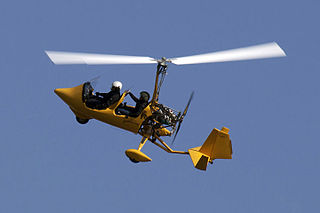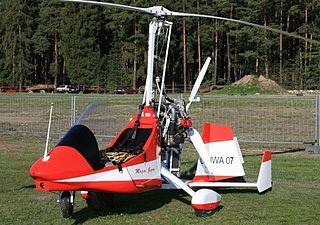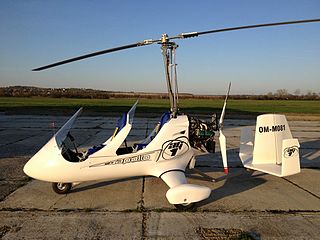
An autogyro, also known as a gyroplane, is a type of rotorcraft that uses an unpowered rotor in free autorotation to develop lift. Forward thrust is provided independently, by an engine-driven propeller. While similar to a helicopter rotor in appearance, the autogyro's rotor must have air flowing across the rotor disc to generate rotation, and the air flows upwards through the rotor disc rather than down.

The Bensen B-8 is a small, single-seat autogyro developed in the United States in the 1950s. Although the original manufacturer stopped production in 1987, plans for homebuilders are still available as of 2019. Its design was a refinement of the Bensen B-7, and like that aircraft, the B-8 was initially built as an unpowered rotor-kite. It first flew in this form in 1955, and on 6 December a powered version, designated B-8M first flew. The design proved to be extremely popular and long-lasting, with thousands of sets of plans sold over the next thirty years.
Christoper Julian, was a motorcycle racer, born in Fraddon, Cornwall, UK. He died in 1997 in a gyrocopter accident at age 60.
The Hinchman H-1 Racer is a 1980s American single-seat autogyro designed by Hank Hincham with plans or a kit available from Hincham Aircraft Company for amateur construction.

The AutoGyro MT-03 is a German autogyro, designed and produced by AutoGyro GmbH of Hildesheim. The aircraft is supplied as a complete ready-to-fly-aircraft.

The ELA 07 is a series of Spanish autogyros, designed and produced by ELA Aviación of Córdoba, Andalusia. The aircraft are supplied complete and ready to fly.

The Magni M-14 Scout is an Italian autogyro, designed and produced by Magni Gyro srl of Besnate. The aircraft is supplied as a complete ready-to-fly-aircraft.

The Trixy G 4-2 R is an Austrian autogyro, designed and produced by Trixy Aviation Products of Dornbirn. The aircraft was introduced at the Aero show held in Friedrichshafen in 2011 and when it was available it was supplied as a complete ready-to-fly-aircraft.
The Air Command Commander Tandem is an American autogyro that was designed and produced by Air Command International of Wylie, Texas. Now out of production, when it was available the aircraft was supplied as a kit for amateur construction.
The Air Command Commander Sport is an American autogyro that was designed and produced by Air Command International of Wylie, Texas. Now out of production, when it was available the aircraft was supplied as a kit for amateur construction.
The Hillberg Turbine Exec is an American helicopter that was designed and produced by Hillberg Helicopters of Fountain Valley, California. Now out of production, when it was available the aircraft was supplied as a conversion kit, for amateur construction.
The Raven Explorer II is an American autogyro designed by Raven Rotorcraft of Boulder Colorado and later El Prado, New Mexico, introduced in the 1990s. No longer in production, when it was available the aircraft was supplied as a kit for amateur construction.
The Rotorwing-Aero 3D-RV is an American autogyro that was designed by Monte Hoskins and produced by Rotorwing-Aero of Salt Lake City, Utah, introduced in 1989. Now out of production, when it was available the aircraft was supplied in the form of plans for amateur construction.
Wombat Gyrocopters was a British aircraft manufacturer based in St Columb, Cornwall and founded in 1991 by Chris Julian. The company specialized in the design and manufacture of autogyros in the form kits for amateur construction.
The Calumet Snobird Explorer is an American autogyro produced by Calumet Motorsports of Lansing, Illinois, introduced in May 1997. Now out of production, when it was available the aircraft was supplied as a kit for amateur construction.

The Apollo Gyro AG1 is a Hungarian autogyro produced by Apollo Ultralight Aircraft, of Eger and introduced in 2012. The aircraft is supplied ready-to-fly.
The Aviomania G2SA Genesis Duo is a Cypriot autogyro designed in 2007 by Nicolas Karaolides and produced by Aviomania of Larnaca. The aircraft is supplied as a complete ready-to-fly-aircraft or as a kit for amateur construction.
The Freewind Bumble B (transl. Bumblebee) is a French autogyro that was designed and produced by Freewind Aviation of Vimory, introduced in about 2013. Now out of production, when it was available the aircraft was supplied complete and ready-to-fly.
The SkyCruiser Autogyro SkyCruiser is a series of Hungarian autogyros designed and produced by SkyCruiser Autogyro KFT of Inárcs. It was publicly introduced at the AERO Friedrichshafen airshow in 2014. The aircraft is supplied complete and ready-to-fly.
The Trixy Liberty is an Austrian autogyro designed and produced by Trixy Aviation Products of Dornbirn. The aircraft is supplied complete and ready-to-fly.







